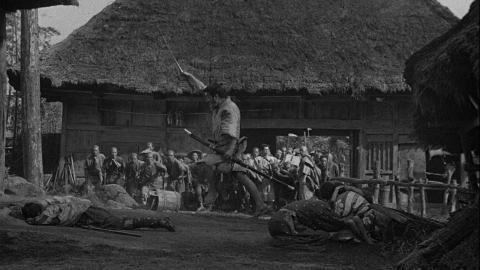Notes on Kurosawa and SEVEN SAMURAI

SEVEN SAMURAI
The following notes on Akira Kurosawa's career and Seven Samurai were written by David Vanden Bossche, PhD student in UW-Madison’s Department of Communication Arts and co-organizer of the Antwerp Summer Film School. A 35mm print of the complete Japanese release version of Seven Samurai will screen on Saturday, December 7, at 7 p.m. in our regular screening venue, 4070 Vilas Hall. Admission is Free!
By David Vanden Bossche
Akira Kurosawa started his career as a scriptwriter and assistant at Toho studios, where he got the chance in 1943 to direct his first feature: the martial arts fantasy Sanshiro Sugata (1943). Already showing an exceptionally keen eye for the kinetic power of ‘jidai-geki’ (period films), Kurosawa made two more films during the war years, showing his maturation as a director in the emotionally powerful The Most Beautiful (1944), a predecessor to his later humanistic masterpieces Ikiru (1952) and Red Beard (1965).
In the immediate aftermath of Japan’s surrender, the country’s film industry was placed under strict control by SCAP (Supreme Command of Allied Powers). SCAP’s film division saw to it that no movie was released that could in any way glorify Japanese military power or stir jingoistic sentiments, while at the same time assuring that the modernization of the national cinema did not yield to many ‘leftist’ ideas. Because of its samurai-themed subject, Kurosawa’s The Men Who Tread on the Tiger’s Tail (1945) was banned, but the post-war years saw the young director’s career generally blossoming. Working with producer Masaichi Nagata – who wanted to export Japanese films to the West and successfully did so – Kurosawa delivered Rashōmon (1950) to the Venice Film Festival, where it won the Golden Lion. Its daring narrative structure (a film that looks at the truth from different vantage points is still said today to have a Rashōmon structure), the director’s subtle use of lighting and his incredible flair for staging and composition propelled Kurosawa to the status of one of the world’s most famous directors on the international festival scene. He held on to that position until the early 1970s, when a suicide attempt following the scathing reviews and commercial failure of Dodes’ka-den (1970) all but destroyed his career, only to be revived by American directors of the ‘movie brat generation.’ Spielberg, Lucas and Coppola ensured financial backing for new work by a filmmaker they all greatly admired; George Lucas famously stated that there would be no Star Wars (1977) without Kurosawa’s The Hidden Fortress (1958).
Kurosawa—who claimed Orson Welles and John Ford had enormous influence on his style—often dealt with protagonists “who curbed selfish desires and worked for the good of others,” as David Bordwell and Kristin Thompson point out in Film History. The director himself acknowledged that much in interviews, stating that “Humanity starts when our instinctive selfishness ends and we open up to others.” That is certainly the case in Seven Samurai, a story about a group of swordfighters who come to the aid of a beleaguered village and are willing to sacrifice their lives to protect the inhabitants from a band of merciless bandits.
The introduction of new and better zoom lenses in the 1950s saw increased use of the device towards the end of the decade (most famously by Roberto Rossellini for Vanina Vanini [1961], shot almost entirely with the SOM-Berthiot zoom), but no director had ever used the zoom lens the way Kurosawa did for Seven Samurai. Using several cameras to shoot the action sequences, the director had his technical crew (under the supervision of the brilliant DOP and longtime collaborator Asakazu Nakai) film the climactic fight sequences in the rain, using the most extreme range of the zoom lenses. The result is a ‘flattening’ of the image plane that experimented on a never seen before scale with the formal language of the action film and that lends the images of brutally stylized violence a radical form of abstraction. These sequences still offer an astonishing aesthetic experience and cemented the director’s reputation as one of the all-time great masters.
Although heavily cut upon its American release in 1956 down to 158 minutes (the UW-Cinematheque is showing the fully restored 207-minute version), the film still was met with rave reviews. Bosley Crowther, critic for The New York Times and an absolute voice of authority on the subject of foreign film releases in the US (as Tino Balio mentions in his 2010 book The Foreign Film Renaissance on American Screens, Crowther could “make or break” a foreign film’s reputation) called Seven Samurai “an extraordinary film that matches Rashōmon in cinema brillance.” The running time and poor marketing made for lowly box-office returns in the US, but the film’s (rightful) reputation as a masterpiece yielded a Hollywood remake by John Sturges as The Magnificent Seven (1960). The remake honor was bestowed on Kurosawa again in 1964 when another of his great samurai films featuring Toshirô Mifune, Yojimbo (1961), was transferred to a desolate setting by Sergio Leone in A Fistful of Dollars (1964) starring Clint Eastwood in the first of a famous string of “Spaghetti Westerns”. An equally powerful remake was headed by the underrated genre specialist Walter Hill, who adapted Yojimbo into a gangster/western hybrid starring Bruce Willis called Last Man Standing (1996).
